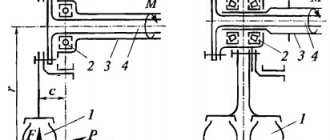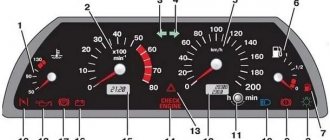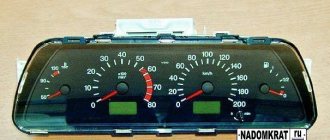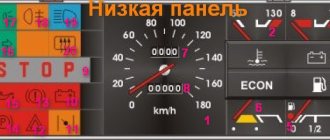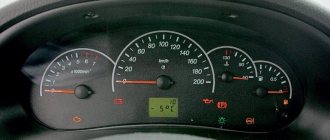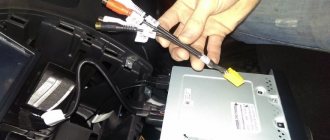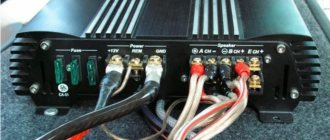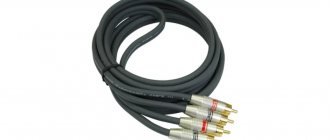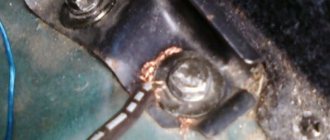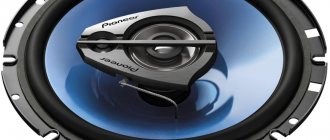Connecting the radio
Correct connection of the head unit ensures its correct operation. There are several ways to supply power, both with and without an ACC cord. Some car enthusiasts, in addition to the control signal, supply power from the REM wire, which is used to power an amplifier or active antenna. 2 diodes are added to the circuit to ensure the correct direction of current. This option allows the receiver to function even when the ignition is turned off.
How to connect with ACC wire
The simplest and most widely used method is to connect power conductors to the cigarette lighter power circuit. However, it is not designed to connect additional consumers. Therefore, as the power increases, a voltage drop occurs, which negatively affects the operation of the power plant. When you turn off the ignition, the radio settings are reset. This is facilitated by the absence of a voltage supply circuit from the battery.
The correct, but more difficult to install option is to connect the red wire to the battery through the fuse block. The yellow signal cable is connected to the ACC terminal of the ignition switch. This connection method makes it possible to listen to the device only after power is supplied to the accessories. When the network is de-energized, the receiver turns off, and the discharge from the battery is reduced to several mA, which does not affect the condition of the battery.
Connection without ACC wire
If the head unit does not provide a control cord, then the connection option may be to connect the power (red) wire to the ACC terminal of the ignition switch. In this case, if the network is de-energized, the tape recorder settings will not be saved. Some vehicles do not have an ACC key position. Then the tape recorder is connected to the battery. To reduce the discharge of the latter, a control button is installed that breaks the power supply circuit of the GU.
This option is preferable to the previous one, since there is no voltage drop when the player’s power increases, and the battery is protected from excessive discharge. Any connection method must be carried out in compliance with safety rules. Poor twisting or poor contact may result in device failure or vehicle fire.
Do-it-yourself car radio installation and connection
Installing a car radio is a creative process, but not very complicated. An experienced car enthusiast, at least a little familiar with the basics of electrical engineering, will be able to connect the car radio with his own hands without any problems. We will tell you in this article how to properly connect a radio in a car, and in what order this should be done.
It should be remembered that an incorrectly installed and connected radio will not only sound bad, but may even lead to a short circuit or even a fire in the car.
A good video instruction for installing and connecting a car radio in a car can be seen in the video at the bottom of this page.
Incorrect connection of the car radio causes the following problems:
- When parked, the radio consumes too much electricity, as a result of which the battery is constantly discharged and if parked for a long time, there is a chance that the engine will not start.
- When listening to music at high volumes, the radio starts to “stutter” and significant distortion of the sound signal appears. Also, at high volumes, the car radio may simply turn off.
- When you turn off the power, the radio settings are lost.
All of these problems in 90% of cases arise due to incorrect connection.
Designations and decoding of radio wires
The rds function in the radio, what is it and how to enable it
Designations, decoding of contacts and wires of car radios.
Acoustic group:
R = Right speaker.L = Left speaker.FR+, FR- or RF+, RF- = Front right speaker (plus or minus, respectively).FL+, FL- or LF+, LF- = Front left speaker (plus or minus, respectively ).RR+, RR- = Rear speaker - right (plus or minus, respectively).LR+, LR- or RL+, RL- = Rear speaker - left (plus or minus, respectively).GND SP = Speaker common wire.
Power connector for radio:
B+ or BAT or K30 or Bup+ or B/Up or B-UP or MEM +12 = Battery powered (plus)
GND or GROUND or K31 or just a minus = Common wire (Ground), battery minus.
A+ or ACC or KL 15 or SK or S-kont or SAFE or SWA = +12 from the ignition switch.
N/C or n/c or N/A = No contact. (Physically the output is there but not connected anywhere).
ILL or LAMP or sun symbol or 15b or Lume or iLLUM or K1.58b = Panel illumination. +12 volts are supplied to the contact when the side lights are turned on. Some radios have two wires, -iLL+ and iLL-. The negative wire is galvanically isolated from ground.
Ant or ANT+ or AutoAnt or P.ANT = After turning on the radio, +12 volts are supplied from this contact to control the retractable antenna, if one is present, of course.
MUTE or Mut or mu or the image of a crossed out speaker or TEL or TEL MUTE = Input to turn off or mute the sound when receiving a phone call or other actions (for example, reversing).
Other possible contacts in radios:
Power Control = this is the control for turning on the amplifierP.CONT/ANT.CONT = this is the control of the antenna, power is supplied after turning on the radioILL + and ILL - = these are the wires for adjusting the brightness of the radio backlightAmp = Control contact for turning on the power of the external amplifierDATA IN = Data InputDATA OUT = Data OutputLine Out = Linear outputREM or REMOTE CONTROL = Control voltage (Amplifier)ACP+, ACP- = Bus lines (Ford)CAN-L = Bus line CANCAN-H = Bus line CANK-BUS = Bidirectional serial bus (K-line)SHIELD = Braid connection shielded wire.AUDIO COM or R COM, L COM = Common wire (ground) of the input or output of preamplifiersCD-IN L+, CD-IN L-, CD-IN R+, CD-IN R- = Balanced linear inputs of the audio signal from the changerSW +B = Switching power supply +B of the battery.SEC IN = Second inputDIMMER = Changing the brightness of the displayALARM = Connecting alarm contacts for the radio to perform car security functions (PIONEER radios)SDA, SCL, MRQ = Communication buses with the vehicle display.LINE OUT, LINE IN = Line output and input, respectively. D2B+, D2B- = Optical audio link
Marking and color coding of wires
Let's look at the color code for car radio wires:
- Black (indicated by GROUND or GND) is the negative of the battery;
- Red (ACC or A+ marking) is the plus of the ignition switch;
- Yellow (indicated by BAT or B+) is the positive from the battery;
- White with a stripe (marked FL-) is the minus of the front left speaker;
- White without a stripe (indicated by FL+) is a plus of the front left speaker;
- Gray with a stripe (marked FR-) is the minus of the right front speaker;
- Gray without a stripe (indicated by FR+) is a plus for the right front speaker;
- Green with a stripe (marked RL-) is the minus of the left rear speaker;
- Green without a stripe (designation RL+) is a plus for the left rear speaker;
- Purple with a stripe (marked RR-) is the minus of the right rear speaker;
- Purple without a stripe (designation RR+) is a plus for the right rear speaker.
Dance and biblical term
During the performance of Lezginka, regardless of the ethnicity of the dancer (i.e.
no matter who it is - Dagestan, Chechen, Ingush, etc.), you can often hear such an exclamation as “assa”
This is shouted by those watching the dancer or dancers. In this way they encourage the performer of the dance, as well as the audience themselves. What is “assa” that sounds during the dance is unknown; this term in this case does not have an exact definition. Such an exclamation can be compared to the Russian “hopa” or “op”, which can also often be heard, only during the performance of Russian folk dance.
Considering what assa is, it should be said about the use of this word in the Bible. In scripture it is written as “asah”, and is read without pronouncing the last letter. "Assa" means to create, to create. However, there are versions that this is a somewhat erroneous interpretation of the word. This refers to its semantic connotation. Namely, that “assa” is not to create and create, but to create the possibility of the existence of something, for example, life itself as such. However, these are controversial assumptions, and supporters of various interpretations have not yet come to a consensus.
Maintaining correct intake
How to connect a subwoofer to a standard Sony radio. connecting the subwoofer to the standard radio. installation nuances in cars of different brands
Only if the parent follows the basic rules for taking ACC powder will he be able to achieve a quick and trouble-free recovery for the child. Acetylsteine powder, according to the instructions, should be consumed according to the following scheme:
- At the age of 2 to 6 years - a whole package or half of it 4 times a day (maximum daily dosage - from 200 to 400 mg, which will depend on body weight).
- Children aged 6 to 14 years can take one sachet three times a day or two sachets - 2 times. The daily dose does not exceed 400 mg.
- Adolescents over 14 years of age are allowed to use two sachets three times a day (dosage no more than 600 mg).
The described treatment regimens for children of different ages have a good effect in the fight against any disease indicated in the instructions, excluding cystic fibrosis. To treat the disease, children aged 2 to 6 years are prescribed 1 packet four times a day; after 6 years, the number of packets increases to two, and the number of doses to 3. If the child weighs more than 30 kg, the daily dosage may increase slightly.
The treatment time with this remedy should not exceed a week. If the disease is chronic or during the prevention of exacerbation, the treatment period may increase, but the final decision will be made by the doctor.
Types of device
There are two types of devices under consideration, which are called passive and adaptive. The first option is a classic system that is used on cars with different types of gearboxes for a long period of time. The main function of passive devices lies in maintaining a certain speed of movement.
The adaptive type is the most interesting and in demand, so we will deal with each type separately.
Passive cruise control and its features
The passive type of cruise control has the simplest design, and such a product is used primarily to maintain a certain speed while driving on highways and highways. The design of the passive device includes the following structural elements:
- Control block. The main device that performs calculations while the car is moving when the option is activated.
- Sensors
- Throttle valve actuator or servo.
The device operates quite simply. To do this, you need to go out of town to a highway with good road surface. It is not rational to use this option, both in city traffic and outside the city on roads with poor-quality road surfaces (if there are potholes and other defects on the roads, as well as on primers). As soon as the car reaches a certain speed, which is optimal for a given area, the cruise control is turned on (manually).
After enabling this option, the microprocessor located in the control unit is responsible for the speed of movement. Sensors determine the speed of the vehicle, as well as the throttle position, and transmit information to the control module. When driving conditions change, which can be ascents and descents, the sensors send appropriate signals.
As soon as the type of track changes when driving uphill or downhill, the sensors send signals to the control unit. The unit analyzes the signals, after which it sends a command to the servo drive, and the throttle valve closes or opens.
Adaptive cruise control and its features
The adaptive type of cruise control is a new generation of the device. This type of device is used on modern cars, and is intended not only to maintain a certain speed limit, but also to take into account the traffic situation. The traffic situation is taken into account using auxiliary devices: sensors, radars and cameras.
The use of adaptive cruise control makes it possible to link your vehicle to the car moving ahead. The speed of the vehicle ahead is taken into account, and a safe distance is maintained, on the basis of which the control unit controls the vehicle.
Location and overview of adaptive cruise control sensors
If the car moving ahead changes speed, the sensors will send corresponding signals to the ECU. The unit will analyze the signals and make a decision to reduce or increase the speed. If there is no vehicle ahead, the device gives a signal to increase the speed to the required value, after which it maintains it.
Adaptive cruise control is designated ACC. This type of system is installed on cars from the factory. The cost of such a system is quite high, due to the use of expensive sensors, cameras and radar. The device also uses a modern control unit, capable of calculating not 2 functions, but several dozen. Depending on the device model, the driver can be notified of an emergency situation ahead by both visual and audio signals.
It is also important to note the fact that the adaptive cruise control system operates in tandem with the ABS anti-lock braking system and ESP. If one of these systems does not function, it will be impossible to activate cruise control.
It is recommended to turn on adaptive cruise control when cars are moving at a uniform speed outside the city.
Displaying the adaptive cruise control system on the vehicle's on-board computer
If the vehicle design does not have an adaptive type of cruise control, then its installation does not make justifiable sense. Although this system is more advanced and modern, a passive device is quite sufficient for trips outside the city.
What is ACC on a radio and how to connect it correctly
Registered: 09/26/2008 Messages: 21
Where to attach the ACC (red) power cable to the radio?
Subsequent topics with “stupid” names will simply be deleted. The title has been corrected. Quasar
AndriK on Okul
Registered: 08/02/2007Messages: 3377From: Taganrog 61 "OKULA" Vmax 168.3 km/h
To the “+” battery!
Registered: 02/15/2008Messages: 445From: Kazan. Car: Oka 111130 2006-Mlechka
Registered: 09/26/2008 Messages: 21
ALPINE Searched. Have not found.
AndriK on the Oculus It should receive +12 when the ignition is on.
Registered: 07/28/2006 Messages: 1183 From: Moskvangeles
ALPINE Searched. Have not found.
AndriK on the Oculus It should receive +12 when the ignition is on.
Registered: 09/26/2008 Messages: 21
Registered: 06/29/2007 Messages: 16380 From: Moscow-SVAO. Oka 0.75, Daihatsu Mira 0.66, Toyota LiteAce 2.2TD
Registered: 09/26/2008 Messages: 21
Registered: 08/14/2007Messages: 4697From: Svyardlovsk region
If you try a little and change the stock one (I highly recommend doing this, as it was discussed in the forum once) with a Volgov 3110, then. 3 additional outputs appear (just connect the wiring to additional equipment.
We attach the radio to it. Through the front (at 15-20A). If we want, we do it before working from the lock (not my option!), if we want, we do it permanently.
Registered: 11/26/2007Messages: 1646From: Murom, MB A140 Classic, ML320
voice
Article rating
Designations, decoding of contacts and wires of car radios.
Acoustic group:
R = Speaker right. L = Speaker left. FR+, FR- or RF+, RF- = Front speaker - right (plus or minus, respectively). FL+, FL- or LF+, LF- = Front speaker - left (plus or minus, respectively). RR+, RR- = Rear speaker - right (plus or minus, respectively). LR+, LR- or RL+, RL- = Rear speaker - left (plus or minus, respectively). GND SP = Speaker ground.
Power connector for radio:
B+ or BAT or K30 or Bup+ or B/Up or B-UP or MEM +12 = Battery powered (plus)
GND or GROUND or K31 or just a minus = Common wire (Ground), battery minus.
A+ or ACC or KL 15 or SK or S-kont or SAFE or SWA = +12 from the ignition switch.
N/C or n/c or N/A = No contact. (Physically the output is there but not connected anywhere).
ILL or LAMP or sun symbol or 15b or Lume or iLLUM or K1.58b = Panel illumination. +12 volts are supplied to the contact when the side lights are turned on. Some radios have two wires, -iLL+ and iLL-. The negative wire is galvanically isolated from ground.
Ant or ANT+ or AutoAnt or P.ANT = After turning on the radio, +12 volts are supplied from this contact to control the retractable antenna, if one is present, of course.
MUTE or Mut or mu or the image of a crossed out speaker or TEL or TEL MUTE = Input to turn off or mute the sound when receiving a phone call or other actions (for example, reversing).
Other possible contacts in radios:
Power Control = this is the control for turning on the amplifier P.CONT/ANT.CONT = this is the control for the antenna, power is supplied after turning on the radio ILL + and ILL - = these are the wires for adjusting the brightness of the radio backlight Amp = Control contact for turning on the power of the external amplifier DATA IN = Data input DATA OUT = Data output Line Out = Line output REM or REMOTE CONTROL = Control voltage (Amplifier) ACP+, ACP- = Bus lines (Ford) CAN-L = CAN bus line CAN-H = CAN bus line K-BUS = Bidirectional serial bus (K-line) SHIELD = Shielded wire braid connection. AUDIO COM or R COM, L COM = Common wire (ground) of the input or output of preamplifiers CD-IN L+, CD-IN L-, CD-IN R+, CD-IN R- = Balanced line inputs of the audio signal from the SW+ changer B = Power switch +B battery. SEC IN = Second input DIMMER = Changing the brightness of the display ALARM = Connecting alarm contacts for the radio to perform car security functions (PIONEER radios) SDA, SCL, MRQ = Communication buses with the car display. LINE OUT, LINE IN = Line output and input, respectively. D2B+, D2B- = Optical audio link
Directions for use and doses
For adults and children over 14 years of age, prescribe 400-600 mg of acetylcysteine per day in 1-3 doses.
For children aged 6 to 14 years, prescribe 400-600 mg per day, divided into 2-3 doses.
For children aged 2 to 6 years, prescribe 200-400 mg per day, divided into 2 doses.
It is recommended to take the drug after meals. Dissolve the contents of the sachet with stirring in ½ glass of hot water and drink, if possible, hotter. Additional fluid intake enhances the mucolytic effect of the drug.
The duration of treatment for chronic diseases is determined by the doctor depending on the nature and course of the disease. For acute uncomplicated diseases, use acetylcysteine for 5-7 days.
What does ACC mean on the radio?
Power to the car radio is supplied by two wires: power with a voltage of +12V yellow, black with a voltage of -12V. The ACC wire (also called signal wire) acts as a control wire and if it is not powered, the GU will not start. The ACC wire on the radio will be energized when the key is turned in the ignition switch.
The +B power wire has a constant voltage of +12V and allows you to store the necessary information in the car radio's memory (station frequencies, last played track, etc.) Unlike +V with a constant voltage, a signal is supplied to the ACC signal wire only when the head unit is running.
What is ACC
The car radio is powered by a yellow power cable connected to the battery and a black (-12 V) cable connected to the car body or the negative terminal of the battery. With this connection scheme, the GU will not be able to work, since there is no control signal. For this purpose, there is a red cord connected to the ignition switch.
When the key is turned to the ACC position, which means “accessory”, on-board consumers receive power, incl. control voltage is supplied to the GU. After this, you can control the device or it will turn on automatically if it was turned off by a power outage in the vehicle network.
Order in Moscow pharmacies
The information provided on drug prices does not constitute an offer to sell or purchase goods.
The information is intended solely for comparing prices in stationary pharmacies operating in accordance with Article 55 of the Federal Law “On the Circulation of Medicines” dated April 12, 2010 N 61-FZ.
| Drug name | Price for 1 unit. | Price per pack, rub. | Pharmacies |
| ACC granules for the preparation of a solution for oral administration 200 mg orange(s), 20 pcs. package (bag) made of combined material 3 g, cardboard pack 20 EAN code: 4030855000036 No. P N015474/01, 2009-11-16Hexal AG (Germany) | |||
| 5.3 | |||
| 5.3 | |||
| ACC granules for the preparation of a solution for oral administration 100 mg orange(s), 20 pcs. package (bag) of combined material 3 g, cardboard pack 20 EAN code: 4030855000029 No. P N015474/01, 2009-11-16Hexal AG (Germany) | |||
| 5.7 | |||
| 5.75 | |||
| ACC granules for the preparation of a solution for oral administration 200 mg, 20 pcs. package (sachet) made of combined material 3 g, cardboard pack 20 EAN code: 4030855511211 No. P N015474/01, 2009-11-16Sandoz dd (Slovenia) | |||
| 6 | |||
| 9.3 | |||
| ACC powder for the preparation of solution for oral administration 200 mg orange(s), 20 pcs. package (bag) of combined material 3 g, cardboard pack 20 No. P N015474/01, 2009-11-16Sandoz dd (Slovenia) | |||
| 6.3 | |||
| ACC granules for the preparation of a solution for oral administration 200 mg, 20 pcs. package (bag) made of combined material 3 g, cardboard pack 20 EAN code: 4030855000050 No. P N015474/01, 2009-11-16Hexal AG (Germany) | |||
| 6.5 | |||
| ACC granules for the preparation of a solution for oral administration 600 mg, 10 pcs. package (bag) of combined material 3 g, cardboard pack 10 No. P N015474/01, 2009-11-16Sandoz dd (Slovenia) | |||
| 13.4 | |||
| ACC powder for the preparation of solution for oral administration 600 mg, 6 pcs. package (bag) of combined material 3 g, cardboard pack 6 No. P N015474/01, 2009-11-16Sandoz dd (Slovenia) | |||
| 20.17 | |||
| ACC granules for the preparation of solution for oral administration 600 mg, 6 pcs. package (bag) made of combined material 3 g, cardboard pack 6 EAN code: 4030855000067 No. P N015474/01, 2009-11-16Hexal AG (Germany) | |||
| 20.17 | |||
| ACC granules for the preparation of solution for oral administration 600 mg, 6 pcs. package (bag) three-layer 3 g, cardboard pack 6 EAN code: 4030855511228 No. P N015474/01, 2009-11-16Sandoz dd (Slovenia) | |||
| 22.83 | |||
| ACC syrup 20 mg/ml, 1 pc. dark glass bottle 100 ml with a measuring cup (cup) and a dosing syringe, cardboard pack 1 EAN code: 4030855504855 No. LP-002668, 2014-10-21Sandoz dd (Slovenia) | |||
| 202.9 |
ACC mode ignition switch
Post by Ollegg » 02 Sep 2010 23:03
Post by gomel » 02 Sep 2010 23:10
Post by Slasher » 03 Sep 2010 00:00
Post by phoptik » 03 Sep 2010 09:29
Post by Ollegg » 03 Sep 2010 11:19
How did you figure out what it consumes and how much?
in any case, it will consume something, even with the socket removed, otherwise the settings will be reset if a couple of LEDs are lit in sleep mode, then that’s nonsense, it won’t consume much
In general, I did not expect such perversions from the branded electronics manufacturer Pioneer when I installed the P700BT a year and a half ago (it cost 8000-9000 rubles at that time) - neither with power nor with settings
As a result, it turns out that you can turn it on either automatically when you turn on the ignition, or manually with a button - there’s no way to connect both methods together. and when you disconnect the battery, you need to configure everything again.
phoptik it won’t work for PionEr to work, you need to put “+” in two points.
Post by Simss » 03 Sep 2010 12:09
Results: how can you evaluate the performance of ASR on a car?
It is difficult to give an unambiguous assessment of this set of security systems. As part of ESP, this unit copes well with certain nuances at low speeds. But when driving along the highway, ASR can even prevent the driver from correcting the situation on his own. The benefits of braking a wheel during slippage are also controversial.
Unfortunately, ASR is not a replacement for a good mechanical lock, as the electronics cannot distribute torque across all drive wheels as effectively. However, this is a solution for those cars in which there cannot be any blocking. If you have the choice of optionally installing such a system, then you should take advantage of this offer.
what does it mean and how to connect
When installing a head unit, car enthusiasts often encounter problems with wire pinout. It’s good if the car owner is well versed in such issues and can independently connect the radio, even with some nuances that arise during the installation process. If there is no such experience, then even a small trifle can drive you into a dead end. In this article we will look at what ACC means on a radio and the features of its connection when installing a car radio.
What does ACC mean on the radio?
Power to the car radio is supplied by two wires: power with a voltage of +12V yellow, black with a voltage of -12V. The ACC wire (also called signal wire) acts as a control wire and if it is not powered, the GU will not start. The ACC wire on the radio will be energized when the key is turned in the ignition switch.
The +B power wire has a constant voltage of +12V and allows you to store the necessary information in the car radio's memory (station frequencies, last played track, etc.) Unlike +V with a constant voltage, a signal is supplied to the ACC signal wire only when the head unit is running.
How does ASR work?
Connecting the multifunction steering wheel to a Chinese radio
ASR OFF button to turn off the ASR system
The ASR system prevents wheel slip in three ways:
- By slowing them down;
- Reducing the torque of the power unit;
- A combination of the first two methods.
If the car is moving at a speed not exceeding 80 km/h, then ASR, when it detects that any of the wheels is spinning faster than the others, brakes it using the braking system. If the speed exceeds this limit, then the rotation speed of the too “fast” wheel is reduced by reducing the torque of the power unit transmitted to it. A combination of these methods is considered the most effective and is used when the car is moving at a sufficiently high speed.
The operation of ASR is controlled by a special electronic unit. It receives signals from many sensors that monitor the most important parameters of the vehicle. This information is processed by the software embedded in the block, resulting in the generation of control signals transmitted in real time to actuators.
The ASR traction control system changes the braking force according to a specific cycle. As soon as its control unit receives information from the sensor about excessive wheel speed, a signal is generated to increase the pressure in the corresponding circuit of the brake system. It follows the actuator, which is triggered. The slipping wheel is braked, and an element of the executive part of the system, such as a return pump, maintains increased pressure until the wheel speed is completely normalized. As soon as this happens, a signal from the sensor enters the control device, and it issues a pressure release command, which is immediately executed.
Counteracting wheel slip by regulating the torque of the internal combustion engine is carried out using the internal combustion engine control system. At certain speeds, when wheel slip occurs, this is detected by the ASR control unit and a corresponding signal is sent to the engine control unit. The latter, in accordance with it, brings the torque to the required values. This is done in the following ways:
- Changing the throttle position;
- Adjusting fuel injection parameters;
- Regulating the pulses of the ignition system.
In some versions of ASR systems, torque control is also achieved by varying the gears. This method is used on cars equipped with automatic transmissions.
Answers
Wolfsangel 6 (17779) 2 3 14 8 years
B+ => battery positive, plus power, bold wire. Rem – Remote – throws either to ACC or to the radio – based on a signal from this wire, the amp turns on and off – you need to avoid consuming current when the mafon/engine is turned off and not to put it on It has a separate switch. GND – ground – body, also known as minus.
On the amplifier, rem. Typically refers to remote control. For car audio amplifier, the remote connection can be for the remote control. Typically this is a dial on one end and a telephone jack, for example, connecting to the other. This allows you to reduce the gain or volume on the amplifier wherever you want to mount the remote. If there is a terminal (screw and clamp for fastening wires) under the rem mark, then for remote shutdown. A remote shutdown for external amplifiers, such as subwoofers or high-level speakers, connects a thin blue wire from the head unit or radio to the amplifier. For head units or radios, the remote connection is connected to the ignition system. They both allow you to turn off the amplifier when the key or radio is in the off state. For home theater amplifiers, the remote connection can be for several things. This could be for an IR receiver or an infrared receiver, or for control from another device. These two are usually a 3.5mm female connector. If it looks like a 2-prong 110V outlet, it will cut off power to the other device when the amp turns off.
The radio is a built-in device designed to connect to the vehicle’s on-board system and additional devices for which it acts as a head unit. To enable such communications, standardized interfaces have been developed for these purposes, providing connections to specific pins on an electronic circuit. For each such output, not only a standard interface has been developed, but also a name that simplifies search and connection. This review gives the most common decoding of radio tape recorder designations using Pioneer as an example.
Connecting the radio
Why does a goat need an accordion in the kingdom of Nesmeyan?
Why do you need Wi-Fi in a car radio? Let's answer briefly - we need it. Today, almost any smartphone is capable of distributing the Internet via Wi-Fi. Although in this case it is more convenient to install a USB modem and establish a full connection with the navigator. A Wi-Fi module with an antenna turns the radio into a router with a convenient tariff plan.
The radio can be powered from a car battery for quite a long time. Longer than it takes to charge a smartphone. It makes sense to consider the device as a backup.
Who needs and in what cases is NFC used in a car radio ? NFC is a communication technology with a fundamentally short range. That is why this protocol is used in payment systems, for locks, tickets and access systems.
The advantage of the system is that the NFC antenna can be very miniature and does not require power. The active module is able to read tags and perform pre-defined actions. For example, when the system reads the chip of your smartphone, the radio can connect via a wireless interface automatically. Programming NFC tags for a radio is a rather tedious task due to the limited capabilities of the device’s processor. Purely technically, you can cut NFC chips from used travel cards and write an action script for each. But it’s much more convenient to set up voice control via a smartphone.
GND on the motherboard circuit in the radio or camera: what is it
Many people are interested in what role GND plays on the motherboard or radio circuit diagram and what it even is. Literally, this is “earth” (from the English word “ground”). Some also use the term to mean "mass" or "minus". In fact, this is a common wire, which is usually white or black. The last option is more common. However, there are other power cord options. For example, blue, green, orange, red and yellow.
It is important to consider the following decodings when repairing the motherboard:
- GND (ground or ground). We are talking about the zero potential point of the microcircuit.
- VEE (Voltage Emitter Emitter) In this case, we mean the minus of the power supply in relation to GND.
- VCC (Voltage Collector Collector is a “voltage collector”). This is just a plus of power in relation to GND.
It is also important to consider that the abbreviation GND may have a slightly different form, for example, DGND, GNDD. This is how digital land will be designated
Analog ground, in turn, can be designated by the abbreviations AGND or GNDA.
To understand the essence, an elementary example should be given. It was necessary to connect an additional fan in the computer case to prevent the unit from overheating. Standard capacity was not enough. Zero fan, black wire was connected to the molex connector wire on the power supply. By the way, it is also made in black. In this case, this is “earth”.
The power supply to the fan itself was yellow. It was connected to a Molex power cable of the same color.
Important! In this case, you should understand simple “arithmetic”:
- When the yellow and black cords are connected, the output is a charge of 12 W.
- The combination of red and black gives only 5 volts.
This is important to consider in order to calculate the required voltage. Otherwise, a short circuit and subsequent malfunction may occur, which is sometimes impossible to eliminate.
By the way, you can also find “POWER” markings on the board and connectors. Here it means nutrition (with a plus sign).
Be sure to pay attention to the sockets with connectors. Sometimes, their design can eliminate incorrect connections
By the way, the computer buttons themselves, for example, reboot and turn on, do not matter at all how you connect them, because the main thing here is the circuit. Pros and cons do not play any role here
Assa River
Assa is also the name of rivers that are located in different countries. For example, in the northern Caucasus the Assa River flows, which originates from the northern slope of the main Caucasian ridge in Georgia and flows through the lands of Chechnya and Ingushetia. Its length is 133 km, and its drainage area is 2060 km2.
Continuing to consider what Assa is, it is necessary to mention a tributary of the Astiko River, which also bears the name Assa.
In the Republic of Kazakhstan there is the Asy River, also called Assa. It flows through lakes Akkol and Bilikol. The river reaches a length of 253 km, and its drainage area is approximately 9 thousand km2. It is a tributary of the Talas River.
As can be seen from the article, the word “assa” has several meanings, sometimes controversial. However, today there are no older sources for its use than the Bible. In this regard, in general understanding the term “assa” means to create or create.
How to properly connect to an electronic device
The concept of an interface as we know it today dates back to the 1960s. More precisely, in 1964, when the company developed its legendary IBM System/360 mainframe. It was then that the main tasks of any interface - physical or virtual - were formulated. They were to provide a standard connection for all devices.
Euro connectors
Initially, only a few types of standard inputs could be made to ensure compatibility between products from different manufacturers. This was a PS/2 port for the keyboard, an LPT port for the printer, and a connector for the PCI card. Nowadays, each type of connection has its own standard interface; this approach greatly simplifies the development and sale of any type of device and allows you to understand their built-in capabilities. Here are descriptions of the main communication elements, first of all, the designation of the button on the radio, which are used on the panels of Pioneer and other car radios.
Description of the buttons on the front panel of the radio for control (decoding)
| Button labels | Button function |
| A.F. | Different RDS frequency, automatic search when reception is poor |
| ALL OFF | Everything is off |
| AMS | Music sensor, works on the principle of playing a number of tracks equal to the number of clicks |
| ANG | Panel adjustment |
| ATA | The radio turns on automatically when you turn off and rewind media tracks |
| A.T.T. | Quickly reduces volume |
| BAND | Selecting a radio receiver |
| BEER | Enabling sound when pressing buttons |
| Blank Skip | Skips pauses longer than 8 seconds |
| BMS | Compensates for low frequencies when dropped due to the main device |
| BTM | Remembers the quality frequency of strong stations |
| CLK ADJ | Adjusts time |
| COLOR | Color |
| DISP | Display activation |
| DNPP | Selecting a CD in the changer |
| DNPS | Entering disc names |
| DSP | Activating the sound processor |
| EJECT | Remove the cassette from the cassette receiver or disc |
| EON | Reception of traffic information |
| FUNCTION | Switches the most used functions |
| INTO SCAN | Plays the recording for 10 seconds to search |
| LOS | Looks for stations, skipping with weak reception |
| LOUD | Tone compensation |
| M.RDM | Disc random playback |
| P.I. | Automatic search |
| PI SOUND | Switching to another frequency |
| PI MUTE | Muffled sound |
| POWER | Shutdown |
| PS | Listening to saved settings |
| PTY | Selecting a genre |
| RDS | Search for a station by metadata |
| RDM | Play disc tracks in any order |
| REG | Switching to the frequency of a radio station with RDS |
| Repeat Play | Replaying a track |
| SCAN | Scanning tracks and playing the beginning |
| SEL | Settings |
| SHUFFLE PLAY | Play available music in random order |
| SYSTEM Q | Tracking sound enhancement factors and showing them on the display |
| TA SEEK | Searching for a station with RDS |
| TC | Calling the tuner when rewinding |
Release form and composition
The following types of the drug are produced:
- Effervescent tablets ACC 100, ACC 200 and ACC Long, containing 100 mg, 200 mg and 600 mg of acetylcysteine, respectively;
- Solution for intramuscular and intravenous administration ACC Inject, 1 ml of which contains 300 mg of acetylcysteine;
- Granules for the preparation of a solution for oral administration ACC, one package contains 100 or 200 mg of acetylcysteine - granules with the smell of orange, 200 or 600 mg of the active substance - granules with the smell of lemon and honey;
- Orange granules for the preparation of syrup for oral administration of ACC. 5 ml of finished syrup contains 100 mg of acetylcysteine.


